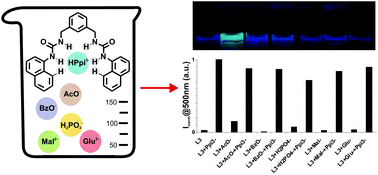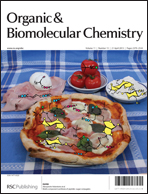A new family of bis-ureidic receptors (L11–L66) has been synthesised. The binding properties of L11–L66 towards different anions (acetate, benzoate, glutarate, malonate, dihydrogen phosphate, hydrogen pyrophosphate, triphosphate, AMP and ADP) have been studied by means of 1H-NMR, UV-Vis and fluorescence spectroscopies and a remarkable affinity for HPpi3− has been observed in the case L33 (in DMSO-d6 and DMSO-d6–5% H2O) which also acts as a fluorimetric chemosensor, even to the naked eye, for this anion. Theoretical calculations helped us explain the binding properties observed.
You have access to this article
 Please wait while we load your content...
Something went wrong. Try again?
Please wait while we load your content...
Something went wrong. Try again?


 Please wait while we load your content...
Please wait while we load your content...